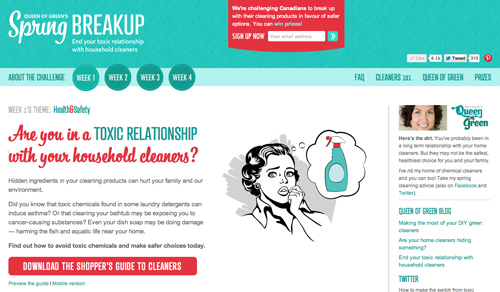
I’m not! I switched to vinegar and baking soda for most tasks years ago. I’m even considering making my own laundry detergent after I move out.
I have a confession to make, though: I used to like the smell of Mr. Clean. I’m sure a whiff of it now would send me into an allergic frenzy, but I broke up with Mr. Clean a long time ago. You can too, by going to SpringBreakup.ca, a campaign site my team at the David Suzuki Foundation recently launched with our Queen of Green.
Continue reading Are you in a toxic relationship with your household cleaners? »
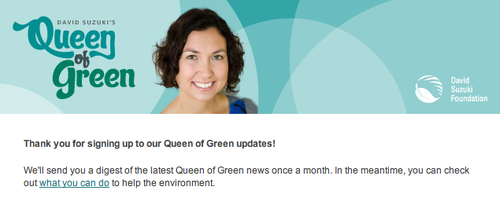
Queen of Green emails
While I’m mainly devoted to the web in my design practice as well as at my job, I do wear many hats in my work at the David Suzuki Foundation. I recently took on a rebrand of David Suzuki’s Queen of Green, the Foundation’s expert on green living and one of our most public faces. The Queen of Green, Lindsay Coulter, writes a weekly blog, offers tips and recipes, and has regular media appearances. Her recipes and other public materials lacked cohesive, formally executed branding, so when it was time to have a fresh go at the content of her resources, we gave her work a proper identity.
Continue reading David Suzuki’s Queen of Green gets a facelift — the brand, that is »
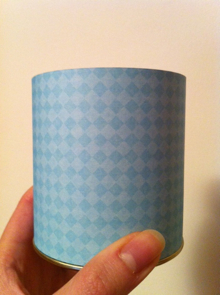
I had a tea container I couldn’t recycle, so I repurposed it with a strip of cute paper.
GOOD Magazine‘s latest contest asked for photographs of something repurposed and today they announced the winner, beautiful lamps made from glass bottles, by Lauren Lee. They’re stunning and blur art and design together, in the sense that she used essentially a readymade and added both intent and function.
Contributor Ivy Lane calls repurposing objects and materials “upcycling”, in stark contrast to downcycling, which typically refers to the deterioration of plastic as it undergoes multiple recycling processes. Repurposing is the ultimate sustainable thing to do with stuff that already exists. It extends its life, creates something new (our brains thrive on novelty, hence the rampant consumer culture), and inspires creative thinking to imagine objects being used for another purpose in new combinations. It’s easy to think of repurposing as taking something easily recyclable and giving it a new lease on life, but where it succeeds most wonderfully is in saving garbage-bound objects from an eternity in a landfill, bringing to mind the old adage, “One person’s trash is another’s treasure.” (Just check out some select submissions to see what I mean.)
I hope repurposing can find a home nestled between the handmade revolution and high design so as to appeal to anyone. In fact, there is no reason it cannot.
 This daily green blog challenge is in celebration of David Suzuki’s 75th birthday, supporting the David Suzuki Foundation. Please help me out by sponsoring me online now.
This daily green blog challenge is in celebration of David Suzuki’s 75th birthday, supporting the David Suzuki Foundation. Please help me out by sponsoring me online now.
Note: I am writing solely on my own behalf, and do not claim to represent the David Suzuki Foundation or its views here.
Oh my goodness! I’m nearly at my $300 fundraising goal as I write this. Please donate now to support the David Suzuki Foundation. Here’s why I’m fundraising with a daily post!
I was excited when I noticed a dramatic, beautiful piece of art hanging over my head on the bus the other morning. It was Emily Carr University student Alison Woodward’s work (see the eighth image here), one of 31 images by 18 artists studying at the school. It’s TransLink’s new pilot initiative, which is “building on the success of the Poetry in Transit program, which seeks to bring visual art into the transit environment through on-vehicle advertising panels featuring emerging artists.” I quite enjoy the Poetry on Transit panels when I find one I like, and so far, in Art on Transit, I love what I’m seeing.
Continue reading Vancouver’s buses get a little arty »
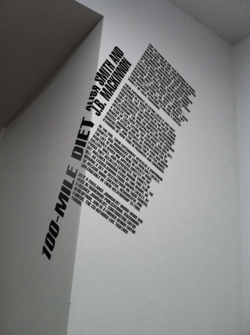
Last week I experienced the WE:Vancouver exhibition at the Vancouver Art Gallery. It’s one of the few shows I’ve seen where the gallery extends beyond art to include design and architecture, and they do it remarkably well. The fact that it’s all local (Jason lamented he didn’t make it in) makes it unique and more personally felt.
It did an excellent job communicating our cultural connection with nature through pieces like compelling manifestos by Alisa Smith and James MacKinnon, authors of The 100-Mile Diet, and the Vancouver Public Space Network; video and installation from the Downtown Eastside’s SOLEfood farm (psst! they’re screening Dirt on March 10); and eco-fashion goddess Natalie Purschwitz’s gorgeous outfits are displayed in photo and video. Other installations embrace our vibrant city and ideas as they focus on public spaces, food, and Critical Mass as they relate to Vancouver and its people.
Without giving away too much, the exhibit is a visual, aural and physical experience. It has its own gorgeous microsite as well, but don’t let it spoil your visit if you browse the site first, and photos are definitely no substitute!
Be sure not to miss Ken Lum’s trippy hall of mirrors on the second floor — take a friend in with you.
WE:Vancouver runs through May 1.
 This daily green blog challenge is in celebration of David Suzuki’s 75th birthday, supporting the David Suzuki Foundation. Please help me out by sponsoring me online now.
This daily green blog challenge is in celebration of David Suzuki’s 75th birthday, supporting the David Suzuki Foundation. Please help me out by sponsoring me online now.
Note: I am writing solely on my own behalf, and do not claim to represent the David Suzuki Foundation or its views here.
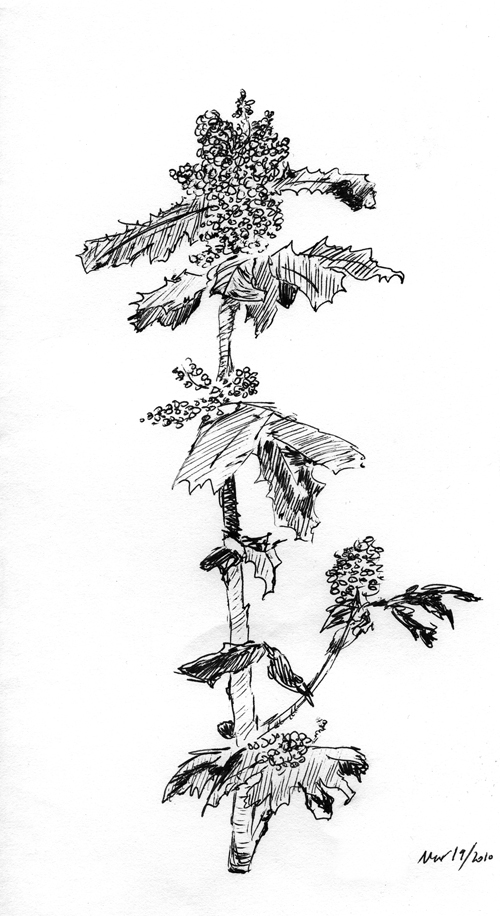
A day before the official first day of spring, my friend and I sat down on a Coal Harbour bench after a refreshing, sunlit bike ride around the seawall. He pulled out a sketchbook and pen and started sketching out as many sights as possible, as quickly as possible. That strategy, while energizing and capable of branding more visual memories, is not one I frequently employ. In fact, I hadn’t done any kind of artistic sketching for months — not since the fall when my visiting nieces, who are nuts about drawing, inspired participation. So when he tore a sheet from his sketchbook and handed it to me with a pen and a book for my lap, I felt a blushing hesitation, a brief resistance. An unfamiliarity with the drawing tool. Overcome that I was left just with deciding what to draw.
There was a large holly with yellow berries just ahead of me that provided the detail to which I’m addicted. I like to draw subjects as close to their form as possible, so botanical drawings are quite ideal, providing intricate and random shapes. I had forgotten this pleasure, as I had forgotten how much I enjoy capturing light and shadow (as much as I do looking at it). It took me a minute to get back into the swing of it, to have some patience and see it as a relaxing exercise with a tangible outcome. It’s so easy to just take photographs and yet if I remember anything vividly it’s the image of that holly, in full colour, not the pansies and daffodils I photographed two days later. That sure makes one think about the media we use to write memories.
Digital scan converted to greyscale from original blue ink.
I could write about how fantastic last year was for me… or I could just show you. Through my lens, last year looked, and felt, like this.
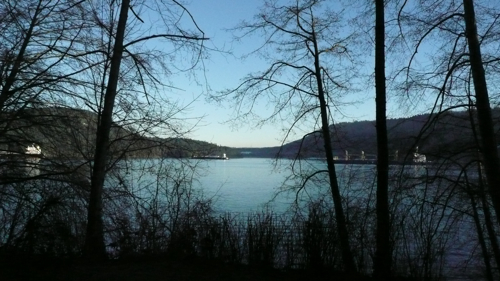
January
In January, I wrote about what I missed when I did not bring my camera, accompanied by photos taken the next day when I did. Of course, the scenery was altogether different, but no less remarkable. There was still evidence of the bewildering snowfall that lingered an unusually long time.
February must have been particularly grim as I only have blurry shots of a crescent moon riding beneath a star or planet.
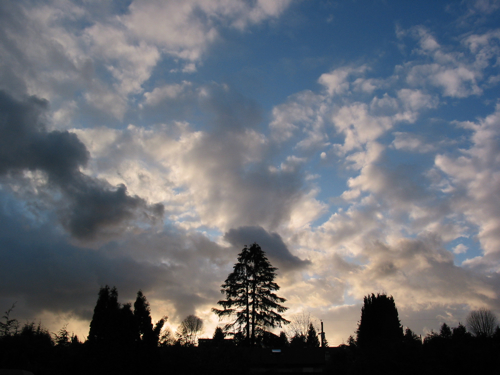
March
Continue reading A year in photos: 2009 »
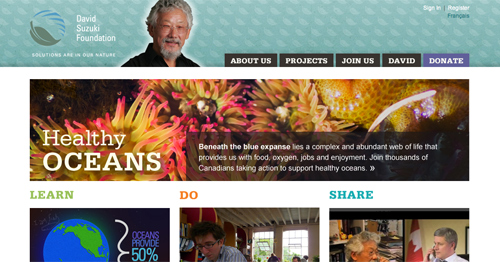
Our team at DSF has been working steadily for months to bring you a new website that lets you — people who care about environmental issues, sustainability, and health — share your ideas, questions, and stories about how we can all make a difference. The site also makes it easy to learn about relevant issues and take action in meaningful ways, big and small.
The design is a significant departure from our old site, which is cluttered and inconsistent. We’ve taken on a new strategy as well: most content is written to fit into either the Learn, Do or Share category, then pulled into project pages where relevant. This allows content to fit into two projects without duplicating pages, gives us flexibility when projects come to an end, and helps you get the freshest content. It’s a more accessible approach than organizing content around our programs, and avoids dividing complex topics like climate change into single issues. Everything is interconnected.
Continue reading David Suzuki Foundation launches new website, blog share »
Three years ago today, I started a blog at Blogger and didn’t really have a name for this new “thing,” didn’t know where it was going, and didn’t know precisely what to write about. I’m still writing about topics almost as broad as my own interests, and frankly, I don’t think I know much better where it’s going but at least it has a name: thirteen cent pinball.
About eight months ago I decided to upgrade my blog from Movable Type version 3 to the much improved 4. In the process, I wanted a wider page with larger font, bigger images, a cleaner and easier commenting section, and better typography. I wanted to eliminate extra steps and hurdles for users, and streamline my own process for updating content across the blog and eventually my portfolio as well.
Regular visitors will recall the blog originally looked like this:
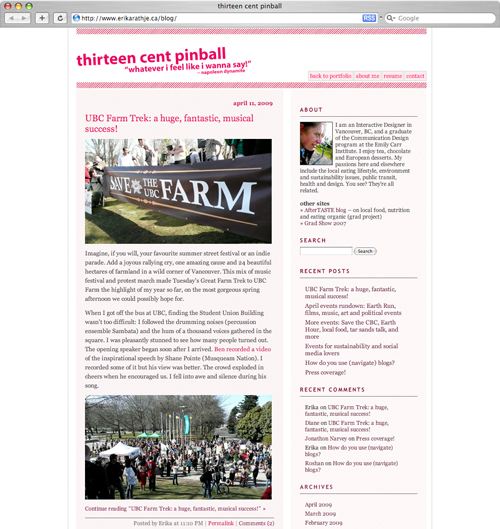
Continue reading New design launched as thirteen cent pinball turns 3 »
I’ve been working for awhile on giving my blog design a facelift. As tends to happen with design projects that are drawn out at length (as is the case when it’s not my full-time work), I know more at the end than I did at the beginning. I mean, yeah, that’s supposed to happen, naturally, with any project, but these ones that would otherwise be condensed into a short time frame take place over the course of months that are packed with learning that occurs outside their context. That learning tends to fall into either design (look at how much better I’ve become!) or programming (look at what I’ve learned how to do!). Sometimes it’s outside influences like new technology that didn’t exist before, or of which I did not know. Well, this time around, it’s not so much my visual skills or my technological skills, but my thinking that has changed and grown since I embarked on this miniature quest. And it’s quite, quite recent.
Blogs and websites are constantly evolving. As a result one can probably expect users to be evolving too — in fact, with the presence of RSS readers, we hardly need spend time on people’s blogs in our web browsers save to comment. User behaviour changes with technology. This is clear. So when I have a model for my blog that is almost 3 years old, I have to wonder… what is still relevant? What features do users actually use and how do they find information?
I googled this already but Google help me I didn’t find an answer. That, therefore, is where you come in. The question I pose you is: how do you use blogs? When you arrive at a post, what helps you move on to another post (assuming you enjoyed the content or found it helpful)? How do you navigate the information — through tag clouds, categories, recent comments? Are lists overwhelming or redundant?
Your feedback will help me determine what features are of most use to you when you read my blog. Thanks in advance for helping me out.
A side note: in its next incarnation, I expect comments to appear immediately on thirteen cent pinball. Hooray! The facelift is a modernization, rather than a redesign, so the overall visual “flavour” of the blog, if you will, shall remain the same.



 I had a tea container I couldn’t recycle, so I repurposed it with a strip of cute paper.
I had a tea container I couldn’t recycle, so I repurposed it with a strip of cute paper.
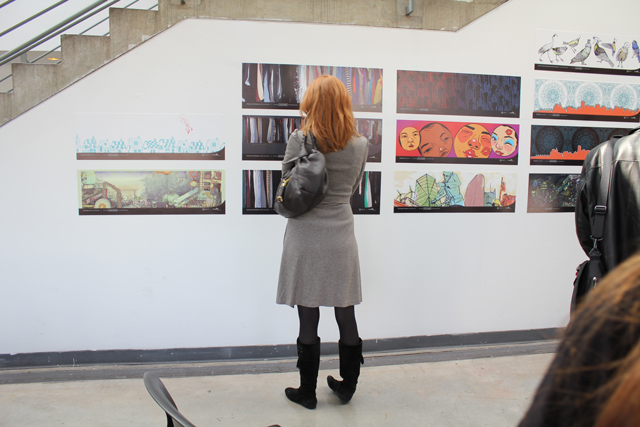 Photo from
Photo from 


 March
March
